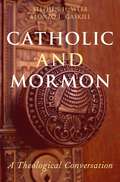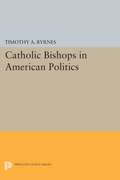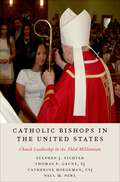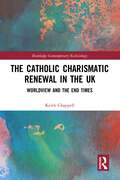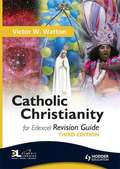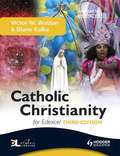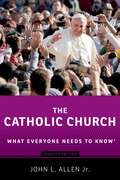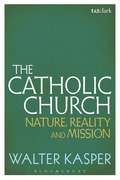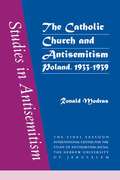- Table View
- List View
Catholic and Mormon: A Theological Conversation
by Stephen H. Webb Alonzo L. GaskillWhat could Roman Catholicism and Mormonism possibly have to learn from each other? On the surface, they seem to diverge on nearly every point, from their liturgical forms to their understanding of history. With its ancient roots, Catholicism is a continuous tradition, committed to the conservation of the creeds, while Mormonism teaches that the landscape of Christian history is riddled with errors and apostasy and in need of radical revision and spiritual healing. Additionally, successful proselyting efforts by Mormons in formerly Catholic strongholds have increased opportunities for misunderstanding, polemic, and prejudice between the two faiths. However, as demonstrated in this unique and spirited dialogue between two theologians, one a convert to Catholicism and the other a convert to Mormonism, these two traditions are much closer to each other than many assume, including in their treatment of central doctrines such as authority, grace, Jesus, Mary, and revelation. Both Catholicism and Mormonism have ambitiously universal views of the Christian faith, and readers will be surprised by how close Catholics and Mormons are on a number of topics and how these traditions, probed to their depths, shed light on each other in fascinating and unexpected ways. Catholic and Mormon is an invitation to the reader to engage in a discussion that makes understanding the goal, and marks a beginning for a dialogue that will become increasingly important in the years to come.
Catholic and Protestant Translations of the Imitatio Christi, 1425–1650: From Late Medieval Classic to Early Modern Bestseller
by Maximilian von HabsburgThe Imitatio Christi is considered one of the classic texts of Western spirituality. There were 800 manuscript copies and more than 740 different printed editions of the Imitatio between its composition in the fifteenth century and 1650. During the Reformation period, the book retained its popularity with both Protestants and Catholics; with the exception of the Bible it was the most frequently printed book of the sixteenth century. In this pioneering study, the remarkable longevity of the Imitatio across geographical, chronological, linguistic and confessional boundaries is explored. Rather than attributing this enduring popularity to any particular quality of universality, this study suggests that its key virtue was its appropriation by different interest groups. That such an apparently Catholic and monastic work could be adopted and adapted by both Protestant reformers and Catholic activists (including the Jesuits) poses intriguing questions about our understanding of Reformation and Counter Reformation theology and confessional politics. This study focuses on the editions of the Imitatio printed in English, French, German and Latin between the 1470s and 1650. It offers an ambitious and comprehensive survey of the process of translation and its impact and contribution to religious culture. In so doing it offers a fresh analysis of spirituality and devotion within their proper late medieval and early modern contexts. It also demonstrates that spirituality was not a peripheral dimension of religion, but remains at the very heart of both Catholic and Protestant self-perception and identity.
Catholic and Protestant Translations of the Imitatio Christi, 1425–1650: From Late Medieval Classic to Early Modern Bestseller
by Maximilian von HabsburgThe Imitatio Christi is considered one of the classic texts of Western spirituality. There were 800 manuscript copies and more than 740 different printed editions of the Imitatio between its composition in the fifteenth century and 1650. During the Reformation period, the book retained its popularity with both Protestants and Catholics; with the exception of the Bible it was the most frequently printed book of the sixteenth century. In this pioneering study, the remarkable longevity of the Imitatio across geographical, chronological, linguistic and confessional boundaries is explored. Rather than attributing this enduring popularity to any particular quality of universality, this study suggests that its key virtue was its appropriation by different interest groups. That such an apparently Catholic and monastic work could be adopted and adapted by both Protestant reformers and Catholic activists (including the Jesuits) poses intriguing questions about our understanding of Reformation and Counter Reformation theology and confessional politics. This study focuses on the editions of the Imitatio printed in English, French, German and Latin between the 1470s and 1650. It offers an ambitious and comprehensive survey of the process of translation and its impact and contribution to religious culture. In so doing it offers a fresh analysis of spirituality and devotion within their proper late medieval and early modern contexts. It also demonstrates that spirituality was not a peripheral dimension of religion, but remains at the very heart of both Catholic and Protestant self-perception and identity.
The Catholic Bible, Personal Study Edition
Informative... Reliable... Accessible First published more than a quarter century ago, The Catholic Bible: Personal Study Edition has long served readers eager for a reliable, accessible guide to lead them into the biblical text. Thumb-indexed for convenience, this third edition is fully revised and augmented with new study aids such as in-text essays on topics that enhance one's reading of the text. The "Reading Guides" that come before the text of the New American Bible Revised Edition -- the translation used in the great majority of U.S. Catholic parishes -- provide a concise, accessible overview of each individual book of the Bible, leading readers through the backgrounds, characters, and messages of all the books and their implications for our lives today. Lay people -- individuals or members of study groups -- students, and general readers will all find essential information in a form that is easy to use and organized for quick reference.
Catholic Bishops in American Politics (PDF)
by Timothy A. ByrnesOver the past twenty years the American Catholic bishops have played a leading role in the antiabortion movement, published lengthy and highly detailed pastoral letters on nuclear weapons and on the American economy, and involved themselves, collectively and individually, in several national election campaigns. What is the source of the sometimes controversial political role of these religious leaders? Timothy Byrnes proposes a new answer in this lucid description of the National Conference of Catholic Bishops and its activities. He demonstrates that the key to the political role of the bishops and other modern American religious leaders has been political change, rather than religious revival.Originally published in 1991.The Princeton Legacy Library uses the latest print-on-demand technology to again make available previously out-of-print books from the distinguished backlist of Princeton University Press. These editions preserve the original texts of these important books while presenting them in durable paperback and hardcover editions. The goal of the Princeton Legacy Library is to vastly increase access to the rich scholarly heritage found in the thousands of books published by Princeton University Press since its founding in 1905.
Catholic Bishops in the United States: Church Leadership in the Third Millennium
by Stephen J. Fichter Thomas P. Gaunt Catherine Hoegeman Paul M. PerlIn the past thirty years, the Catholic bishops of the United States have made headlines with their statements on nuclear disarmament and economic justice, their struggles to address sexual abuse by clergy, and their defense of refugees and immigrants. Despite many similarities, the nearly two hundred U.S. bishops are a diverse mix of varying backgrounds and opinions. The last research- based book to study the bishops of the United States came out in 1989, since which time the Church has gone from Pope John Paul II to Benedict XVI to Pope Francis and undergone dramatic shifts. Catholic Bishops in the United States: Church Leadership in the Third Millennium presents the results of a 2016 survey conducted by the Center of Applied Research for the Apostolate (CARA). It reveals the U.S. bishops' individual experiences, their day-to-day activities, their challenges and satisfactions as Church leaders, and their strategies for managing their dioceses and speaking out on public issues. The bishops' leadership has been tested by changes including the movement of Catholics from the Northeast and Midwest to the South and West, the arrival of huge numbers of Catholic immigrants, and the ongoing decline in the number of priests and sisters serving the Catholic community. This book provides a much-needed, up-to-date, and comprehensive view of who the U.S. bishops of today are, where they are from, and how they are leading the Church in the United States in the era of Pope Francis.
Catholic Bishops in the United States: Church Leadership in the Third Millennium
by Thomas P. Gaunt Stephen J. Fichter Catherine Hoegeman Paul M. PerlIn the past thirty years, the Catholic bishops of the United States have made headlines with their statements on nuclear disarmament and economic justice, their struggles to address sexual abuse by clergy, and their defense of refugees and immigrants. Despite many similarities, the nearly two hundred U.S. bishops are a diverse mix of varying backgrounds and opinions. The last research- based book to study the bishops of the United States came out in 1989, since which time the Church has gone from Pope John Paul II to Benedict XVI to Pope Francis and undergone dramatic shifts. Catholic Bishops in the United States: Church Leadership in the Third Millennium presents the results of a 2016 survey conducted by the Center of Applied Research for the Apostolate (CARA). It reveals the U.S. bishops' individual experiences, their day-to-day activities, their challenges and satisfactions as Church leaders, and their strategies for managing their dioceses and speaking out on public issues. The bishops' leadership has been tested by changes including the movement of Catholics from the Northeast and Midwest to the South and West, the arrival of huge numbers of Catholic immigrants, and the ongoing decline in the number of priests and sisters serving the Catholic community. This book provides a much-needed, up-to-date, and comprehensive view of who the U.S. bishops of today are, where they are from, and how they are leading the Church in the United States in the era of Pope Francis.
The Catholic Charismatic Renewal in the UK: Worldview and the End Times (Routledge Contemporary Ecclesiology)
by Keith ChappellCombining ethnographic research with theological analysis, this book explores how the Catholic Charismatic Renewal (CCR), one of the largest new movements within the global Catholic Church, has developed in contemporary Britain and Northern Ireland. Drawing on extensive fieldwork, this study analyses the beliefs, behaviour, and worldviews of CCR members and considers how these relate to key theological themes in the movement’s unique encounter between Pentecostalism and Catholicism. The author explores the extent to which the CCR has been integrated into the mainstream of the Catholic Church, and how the movement’s members have adapted their theology over time. Painting a picture of a diverse community, this book enriches understanding of the CCR and contemporary Christianity in Britain.
The Catholic Charismatic Renewal in the UK: Worldview and the End Times (Routledge Contemporary Ecclesiology)
by Keith ChappellCombining ethnographic research with theological analysis, this book explores how the Catholic Charismatic Renewal (CCR), one of the largest new movements within the global Catholic Church, has developed in contemporary Britain and Northern Ireland. Drawing on extensive fieldwork, this study analyses the beliefs, behaviour, and worldviews of CCR members and considers how these relate to key theological themes in the movement’s unique encounter between Pentecostalism and Catholicism. The author explores the extent to which the CCR has been integrated into the mainstream of the Catholic Church, and how the movement’s members have adapted their theology over time. Painting a picture of a diverse community, this book enriches understanding of the CCR and contemporary Christianity in Britain.
Catholic Christianity for Edexcel: Revision Guide
by Victor W. WattonSucceed at Edexcel GCSE Religious Studies Units 3 and 8: Roman Catholic Christianity with this revision guide which provides the content you need and guidance on applying it. This revision guide has been written by an expert in order to help you achieve your best in Edexcel GCSE Religious Studies Units 3 and 10. Helps you consolidate your knowledge with bitesize summary of key content Prepares you for your exams with sample examination questions and accompanying exemplar answers Helps you to aim for better grades with useful tips on what the examiner is looking for. Unit 3 - Religion and Life based on a study of Roman Catholic Christianity:nbsp;3.1 Believing in God 3.2 Matters of life and death 3.3 Marriage and the family 3.4 Religion and community Cohesionnbsp; Unit 10 - Catholic Christianity: 10.1 Beliefs and values 10.2 Community and tradition 10.3 Worship and celebration 10.4 Living the Christian Life.
Catholic Christianity for Edexcel (PDF)
by Diane Kolka Victor W. WattonWritten by experts and endorsed by Edexcel, this third edition of the bestselling Catholic Christianity for Edexcel textbook has been fully revised to meet the structure, content and assessment requirements of the new Edexcel GCSE in Religious Studies Specification A, Units 3 and 10. This new edition integrates the requirements of the new GCSE into the familiar and proven format of the previous edition of Catholic Christianity for Edexcel, with: exam-specific advice, questions and model answers a clear, accessible structure to guide students through the course student-focused features to aid learning such as key terms and summary boxes up-to-date photos and examples. This third edition is accompanied by new editions of the Teacher's Resource Pack and Revision Guide and now also is supported and enhanced by a new, simplified Foundation Edition and Dynamic Learning CD-ROM.
Catholic Christianity in Evolution: The Spiritual Prophecy of Teilhard de Chardin
by Alan SageChristianity, and its theological and spiritual underpinnings, does not fulfil the needs of people living in a rapidly changing world. For all its good intention, the Catholic Church has failed to provide the necessary religious tools to its congregants and wider Catholic community to confront the ecological and environmental problems that confront mankind. This book sets out the required parameters of spirituality within an evolutionary world context, linking the theological with the practical, under the aegis of the Jesuit Pierre Teilhard de Chardin. His writings promote a concept of God at the centre of the world we live in - a Christian way of living, fully engaged. At the heart of Teilhard's world view are creation, evolution, and the environment. He provides the spiritual tools to understand a God that is, in real effect, our evolving world and our actions toward it. In looking after God's world through our daily commitment we meet the needs of the whole of creation. And this makes Christian faith truly meaningful and of direct relevance to our living in the world. Indeed, the second encyclical of Pope Francis (Laudato si') with its care for our common home message, is Teilhardian in its outlook. Likewise the Pope's sacrament of the brother teaching. Because of the inextricable link between human activity and the creative work of God, Teilhard saw all human endeavour as holy. Herewith the Ignatian theme of 'finding God in all things', coupled with a cosmic approach to redemption and the notion of ongoing divine creativity. Teilhard's vision is a template for understanding our place in the world, our intimate relationship to the whole of creation and our responsibilities to the environment and to each other. Teilhard asks us to face the challenges of a rapidly changing world as co-creators with God - a tremendous privilege but also an awesome responsibility. An Appendix lists all of Teilhard's writings and their publication sources, divided into five main sections, and further subdivided by topic - an indispensable resource tool for Teilhard scholars, and for readers familiar with The Divine Milieu and The Human Phenomenon.
Catholic Christianity in Evolution: The Spiritual Prophecy of Teilhard de Chardin
by Alan SageChristianity, and its theological and spiritual underpinnings, does not fulfil the needs of people living in a rapidly changing world. For all its good intention, the Catholic Church has failed to provide the necessary religious tools to its congregants and wider Catholic community to confront the ecological and environmental problems that confront mankind. This book sets out the required parameters of spirituality within an evolutionary world context, linking the theological with the practical, under the aegis of the Jesuit Pierre Teilhard de Chardin. His writings promote a concept of God at the centre of the world we live in - a Christian way of living, fully engaged. At the heart of Teilhard's world view are creation, evolution, and the environment. He provides the spiritual tools to understand a God that is, in real effect, our evolving world and our actions toward it. In looking after God's world through our daily commitment we meet the needs of the whole of creation. And this makes Christian faith truly meaningful and of direct relevance to our living in the world. Indeed, the second encyclical of Pope Francis (Laudato si') with its care for our common home message, is Teilhardian in its outlook. Likewise the Pope's sacrament of the brother teaching. Because of the inextricable link between human activity and the creative work of God, Teilhard saw all human endeavour as holy. Herewith the Ignatian theme of 'finding God in all things', coupled with a cosmic approach to redemption and the notion of ongoing divine creativity. Teilhard's vision is a template for understanding our place in the world, our intimate relationship to the whole of creation and our responsibilities to the environment and to each other. Teilhard asks us to face the challenges of a rapidly changing world as co-creators with God - a tremendous privilege but also an awesome responsibility. An Appendix lists all of Teilhard's writings and their publication sources, divided into five main sections, and further subdivided by topic - an indispensable resource tool for Teilhard scholars, and for readers familiar with The Divine Milieu and The Human Phenomenon.
Catholic Christianity With Islam And Judaism (PDF)
by Philip Robinson Andy Lewis Paul Rowan Cathy Hobday Cavan WoodThis Student Book has been endorsed by Edexcel. This textbook offers a brand new approach to the study of Catholic Christianity, which has been developed in close consultation with teachers and religious organisations. Structured according to the new specification with clear, regular summaries, the book provides students with exactly what they need to know for the course, including a choice between Islam and Judaism as a second religion. It also includesPhilosophy and Ethics and St Mark's Gospel. Practice questions are provided for every topic, as well as sample answer activities and exam support.
The Catholic Church: What Everyone Needs to Know® (What Everyone Needs To Know®)
by John L. AllenRoman Catholicism stands at a crossroads, a classic ''best of times, worst of times'' moment. On the one hand, the Catholic Church remains by far the largest branch of the worldwide Christian family, and is growing at a remarkable clip. Yet the Church has also been rocked by a series of scandals related to the sexual abuse of minors by clergy, and, even more devastating, the cover-up by the Church hierarchy. The decade-long crisis has taken a massive financial toll, but the blow to both the internal morale and the external moral standing of the Church has been even steeper. Today, the Church has enormous residual strength and exciting future prospects, but also faces steep internal and external challenges. The question of ''whither Catholicism'' is of vital public relevance, for believers and non-believers alike. In The Catholic Church: What Everyone Needs to Know, John L. Allen, Jr., one of the world's leading authorities on the Vatican, offers an authoritative and accessible guide to the past, present, and future of the Church. This updated edition includes a new chapter on the resignation of Pope Benedict XVI, the election of Pope Francis, and his extraordinary tenure thus far.
The Catholic Church: What Everyone Needs to Know® (What Everyone Needs To Know®)
by John L. AllenRoman Catholicism stands at a crossroads, a classic ''best of times, worst of times'' moment. On the one hand, the Catholic Church remains by far the largest branch of the worldwide Christian family, and is growing at a remarkable clip. Yet the Church has also been rocked by a series of scandals related to the sexual abuse of minors by clergy, and, even more devastating, the cover-up by the Church hierarchy. The decade-long crisis has taken a massive financial toll, but the blow to both the internal morale and the external moral standing of the Church has been even steeper. Today, the Church has enormous residual strength and exciting future prospects, but also faces steep internal and external challenges. The question of ''whither Catholicism'' is of vital public relevance, for believers and non-believers alike. In The Catholic Church: What Everyone Needs to Know, John L. Allen, Jr., one of the world's leading authorities on the Vatican, offers an authoritative and accessible guide to the past, present, and future of the Church. This updated edition includes a new chapter on the resignation of Pope Benedict XVI, the election of Pope Francis, and his extraordinary tenure thus far.
The Catholic Church: Nature, Reality and Mission
by Walter KasperWalter Kasper is already well-known and loved throughout the English-speaking world. He has held high office in the Vatican but until his recent retirement has felt constrained from publishing what he really thinks and his vision of the Church for the future. Kasper brings to conclusion a project that has been pursued for years, as it joins together his greatest monographs on the subject of God's teaching and Christology. The book covers three main topics: Nature, Reality and the Mission of the Church. The introductory section is autobiographical and the reader can see Kasper's personal and theological way in to and with the Church. He develops the actual ecclesiological exegesis - for Kasper the representation of the Being of the Church is not about empirical description, but rather a testimony of being. He emphasizes that nobody is able to apply the stereotypical and idealistic image of the heavens to the critical acknowledgement of the church's present. The program of the Church is ultimately not self-directed but rather remains oriented towards the finalization of the arrival of the kingdom of God and the spiritual healing of the human race.
The Catholic Church: Nature, Reality and Mission
by Walter KasperWalter Kasper is already well-known and loved throughout the English-speaking world. He has held high office in the Vatican but until his recent retirement has felt constrained from publishing what he really thinks and his vision of the Church for the future. Kasper brings to conclusion a project that has been pursued for years, as it joins together his greatest monographs on the subject of God's teaching and Christology. The book covers three main topics: Nature, Reality and the Mission of the Church. The introductory section is autobiographical and the reader can see Kasper's personal and theological way in to and with the Church. He develops the actual ecclesiological exegesis - for Kasper the representation of the Being of the Church is not about empirical description, but rather a testimony of being. He emphasizes that nobody is able to apply the stereotypical and idealistic image of the heavens to the critical acknowledgement of the church's present. The program of the Church is ultimately not self-directed but rather remains oriented towards the finalization of the arrival of the kingdom of God and the spiritual healing of the human race.
The Catholic Church: A Short History (Universal History Ser.)
by Hans KüngA landmark short history of the Catholic Church by the world's greatest living Christian theologian and historian.Hans Kung describes the history of the Roman Catholic Church from its origins in St Paul's Rome, through the disputes of the medieval era to the modern world. He examines the historic tension in the Church between pluralism and exclusivity; how the role of the Pope has changed; the motivations of the great reforming pontiffs; the evolving functions of the bishops and cardinals; the church's enthusiasm for missionary activity; the origins of the Marian cult; and how the shock waves of the Reformation and Counter-Reformation can still be felt today. The book concludes with a searching assessment of how the Catholic faith confronts the immense challenges - from science, from the empowerment of women, from those seeking reform of the Church's strictures against abortion and contraception - in the new millennium.'The sweep is vast and the tale told with pace and passion' Financial Times
The Catholic Church and Antisemitism
by Ronald ModrasInterwar Poland was home to more Jews than any other country in Europe. Its commonplace but simplistic identification with antisemitism was due largely to nationalist efforts to boycott Jewish business. That they failed was not for want of support by the Catholic clergy, for whom the ''Jewish question'' was more than economic. The myth of a Masonic-Jewish alliance to subvert Christian culture first flourished in France but held considerable sway over Catholics in 1930s Poland as elsewhere. This book examines how, following Vatican policy, Polish church leaders resisted separation of church and state in the name of Catholic culture. In that struggle, every assimilated Jew served as both a symbol and a potential agent of security. Antisemitism is no longer regarded as a legitimate political stance. But in Europe, the United States, and the Middle East, the issues of religious culture, national identity, and minorities are with us still. This study of interwar Poland will shed light on dilemmas that still effect us today.
The Catholic Church and Antisemitism
by Ronald ModrasInterwar Poland was home to more Jews than any other country in Europe. Its commonplace but simplistic identification with antisemitism was due largely to nationalist efforts to boycott Jewish business. That they failed was not for want of support by the Catholic clergy, for whom the ''Jewish question'' was more than economic. The myth of a Masonic-Jewish alliance to subvert Christian culture first flourished in France but held considerable sway over Catholics in 1930s Poland as elsewhere. This book examines how, following Vatican policy, Polish church leaders resisted separation of church and state in the name of Catholic culture. In that struggle, every assimilated Jew served as both a symbol and a potential agent of security. Antisemitism is no longer regarded as a legitimate political stance. But in Europe, the United States, and the Middle East, the issues of religious culture, national identity, and minorities are with us still. This study of interwar Poland will shed light on dilemmas that still effect us today.
The Catholic Church and Argentina's Dirty War
by Gustavo MorelloOn August 3rd, 1976, in Córdoba, Argentina's second largest city, Fr. James Week and five seminarians from the Missionaries of La Salette were kidnapped. A mob burst into the house they shared, claiming to be police looking for "subversive fighters." The seminarians were jailed and tortured for two months before eventually being exiled to the United States. The perpetrators were part of the Argentine military government that took power under President General Jorge Videla in 1976, ostensibly to fight Communism in the name of Christian Civilization. Videla claimed to lead a Catholic government, yet the government killed and persecuted many Catholics as part of Argentina's infamous Dirty War. Critics claim that the Church did nothing to alleviate the situation, even serving as an accomplice to the dictators. Leaders of the Church have claimed they did not fully know what was going on, and that they tried to help when they could. Gustavo Morello draws on interviews with victims of forced disappearance, documents from the state and the Church, field observation, and participant observation in order to provide a deeper view of the relationship between Catholicism and state terrorism during Argentina's Dirty War. Morello uses the case of the seminarians to explore the complex relationship between Catholic faith and political violence during the Dirty War-a relationship that has received renewed attention since Argentina's own Jorge Mario Bergoglio became Pope Francis. Unlike in countries such as Chile and Brazil, Argentina's political violence was seen as an acceptable tool in propagating political involvement; both the guerrillas and the military government were able to gain popular support. Morello examines how the Argentine government deployed a discourse of Catholicism to justify the violence that it imposed on Catholics and how the official Catholic hierarchy in Argentina rationalized their silence in the face of this violence. Most interestingly, Morello investigates how Catholic victims of state violence and their supporters understood their own faith in this complicated context: what it meant to be Catholic under Argentina's dictatorship.
The Catholic Church and Argentina's Dirty War
by Gustavo MorelloOn August 3rd, 1976, in Córdoba, Argentina's second largest city, Fr. James Week and five seminarians from the Missionaries of La Salette were kidnapped. A mob burst into the house they shared, claiming to be police looking for "subversive fighters." The seminarians were jailed and tortured for two months before eventually being exiled to the United States. The perpetrators were part of the Argentine military government that took power under President General Jorge Videla in 1976, ostensibly to fight Communism in the name of Christian Civilization. Videla claimed to lead a Catholic government, yet the government killed and persecuted many Catholics as part of Argentina's infamous Dirty War. Critics claim that the Church did nothing to alleviate the situation, even serving as an accomplice to the dictators. Leaders of the Church have claimed they did not fully know what was going on, and that they tried to help when they could. Gustavo Morello draws on interviews with victims of forced disappearance, documents from the state and the Church, field observation, and participant observation in order to provide a deeper view of the relationship between Catholicism and state terrorism during Argentina's Dirty War. Morello uses the case of the seminarians to explore the complex relationship between Catholic faith and political violence during the Dirty War-a relationship that has received renewed attention since Argentina's own Jorge Mario Bergoglio became Pope Francis. Unlike in countries such as Chile and Brazil, Argentina's political violence was seen as an acceptable tool in propagating political involvement; both the guerrillas and the military government were able to gain popular support. Morello examines how the Argentine government deployed a discourse of Catholicism to justify the violence that it imposed on Catholics and how the official Catholic hierarchy in Argentina rationalized their silence in the face of this violence. Most interestingly, Morello investigates how Catholic victims of state violence and their supporters understood their own faith in this complicated context: what it meant to be Catholic under Argentina's dictatorship.
The Catholic Church and Liberal Democracy (Routledge Studies in Modern History)
by Bernt Torvild OftestadThe Roman Catholic Church's critical stance towards liberalism and democracy following the French Revolution and through the 19th century was often entrenched, but the Second Vatican Council of the 1960s saw a shift in the Church's attitude towards democracy. In recent years, a conflict has emerged between Church doctrine and modern liberalism under Popes John Paul II and Benedict XVI. This book is a comprehensive overview of the Catholic Church's relationship to modern liberal democracy, from the end of the 18th century until today. It is a connection that is situated within the context of the history of ideas itself.
The Catholic Church and Liberal Democracy (Routledge Studies in Modern History)
by Bernt Torvild OftestadThe Roman Catholic Church's critical stance towards liberalism and democracy following the French Revolution and through the 19th century was often entrenched, but the Second Vatican Council of the 1960s saw a shift in the Church's attitude towards democracy. In recent years, a conflict has emerged between Church doctrine and modern liberalism under Popes John Paul II and Benedict XVI. This book is a comprehensive overview of the Catholic Church's relationship to modern liberal democracy, from the end of the 18th century until today. It is a connection that is situated within the context of the history of ideas itself.
